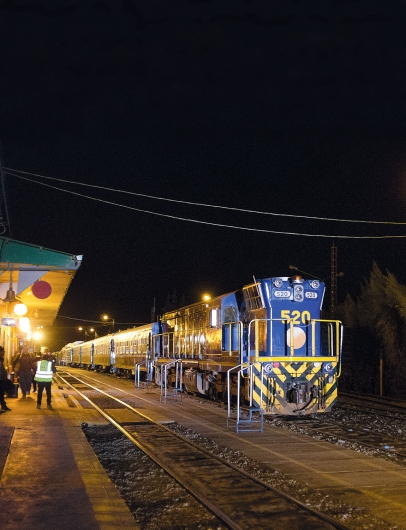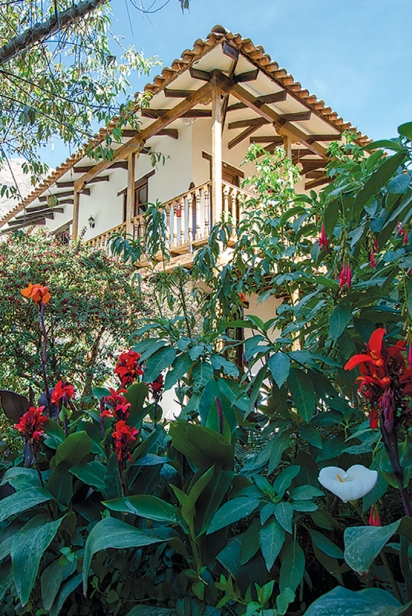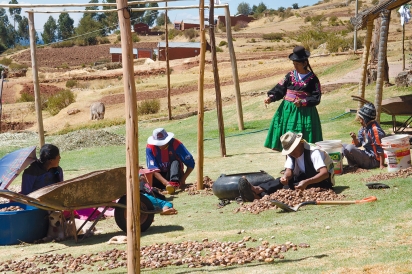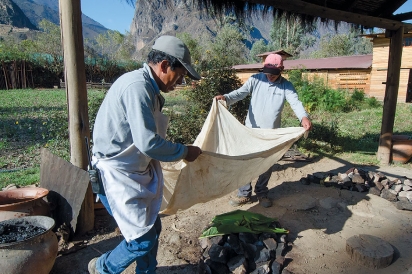P is for Peru, Pachamanca and Potatoes
Headlights pierce the darkness as the locomotive pulls into Ollantaytambo station and screeches to a halt. Passengers on the train, on their way back from Machu Picchu, stare sleepily out the window. People throng the platform and it takes a while before the train clanks its wheels, huffs to a roll again, whistles loud and leaves for Cusco.
Established in 1925—a short decade after local farmers led Hiram Bingham to Machu Picchu in the Andean highlands of Peru—hotel El Albergue is right inside the Ollantaytambo station and our base to explore this end of the Sacred Valley. As the hub for the legendary Inca citadel, the little local station stages a daily show of coming and going trains—and the cacophony that comes with it.
A different scene altogether unfolds behind the hotel’s thick whitewashed walls. One of a lush garden full of herbs and flowers where birds sing and bees hum and where fruit grows ripe for the picking: avocado, papaya, passion fruit and tamarillo, a fascinating egg-shaped tomato that grows on a tree.
The garden gate in the back leads to the hotel’s organic farm, where fields are plowed with oxen, crops are rotated and pests are managed with noninvasive organic methods. Pigs, alpaca and sheep do most of the fertilizing, assisted by chickens and other fowl. Vegetables grown here are used in the hotel’s restaurant.
Part of the farm is a coffee roaster, housed in a shed at the edge of the farm. Frank Cebreros is El Albergue’s resident coffee roaster. “We sell only single-origin, single-harvest, single-roast coffee grown here,” says Cebreros as he brews me a fresh batch of coffee using a siphon. The door is wide open with a sweeping view across the valley. “If you follow the slope down from that glacier,” Cebreros points to the right of the snow-capped mountain in the distance, “you will get to the Convencion Valley.” It’s where the beans grow at 6,400 feet elevation.
Next door, Destilería Andina produces cañazo, a cane liquor that has been produced in the Andes since the 16th century. Using local caña alta, or high cane, cañazo is made from fermented and distilled sugarcane juice rather than from molasses. I peek inside and see the copper alembic still and a colorful array of bottles holding liquids and aromatics—leaves, flowers, twigs. Outside, a pair of alpacas in the field stare at me, eyebrows raised. And I didn’t even try the liquor.
Amidst ancient terraced fields and Inca granaries high on a steep slope, we sit down for a pachamanca prepared on the farm. Pachamanca is a traditional Inca cooking method that uses earth (pacha) as a pot (manca). At the farm, this “earth pot” is a hole under a thatched roof that is filled with sizzling hot stones. Meat—pork, chicken and lamb—goes directly on the stones. So do farm-grown vegetables and a gastronomic mix of local potatoes. More stones and wet cloths go on top and the whole thing is covered with shovels of dirt.
After 20 minutes, the food is carefully uncovered and served with a variety of pepper sauces, salads and jugs of chicha morada, a nonalcoholic beverage made with purple corn grown and dried on the farm.
Combining this original Inca cooking method with organically grown crops that belong here—the potatoes, the grains, the native herbs— El Albergue farm is a testimony to the region’s agricultural heritage. Our train to Machu Picchu is booked for the next day but for now, we kick back and enjoy the view.
Lake Titicaca
A week later, our train—another one—snakes through a barren landscape high in the Andes. We’re headed to Lake Titicaca—at 12,507 feet it is the highest navigable lake in the world.
In the Altiplano (high plains), potatoes are the cream of the crop. Peru is said to have over 4,000 different varieties of potato (including other tubers), and they grow here in the high desert. The majority are wild and rarely harvested, with only about 130 varieties catalogued. Still, with skins the color of cherry, or deep purple, bright yellow, pale pink or black, and an interior to match in variety of color, flavor and texture, even a short list offers a mind-blowing range of potatoes.
It is breathtakingly beautiful on our desolate island in Lake Titicaca. Reeds between beach and lake offer a hiding place for birds, which we discover when a fisherman in a rowboat makes his way into the reeds and birds fly out.
July and August’s clear skies and days of warm sunshine and freezing cold nights make for perfect conditions to preserve the potato harvest: freeze by night, thaw by day. Everyone, young and old, is involved in the ancient process that hasn’t changed much over the centuries: They sit and chat on a grassy slope with a pile of potatoes between them and they work. As the warm sun thaws the potatoes, they squeeze and stomp them to get out as much liquid as possible, then spread them on tarps and blankets to leave them exposed for another night of freezing air. It’s freeze-drying potatoes, Andean style.
The result is known as chuño, from the Quechua-language word for freeze-dried potato. The potatoes shrink and darken as the process is repeated until they are completely shriveled and dried. There is another version, as I discover when I spot buckets full of potatoes soaking in ice-cold water: These will be dried in the full sun until they are chalk-white and light as a feather.
I see our host Aldo in his field, waving at us. His wife, mother, young son and baby—snuggled deep in a carrier blanket on his mother’s back—all huddle around a steaming dirt pit in the field. We recognize it: He’s made a pachamanca. He digs in the steaming hot dirt and, one by one, he picks out cooked potatoes with his bare weathered hands. He beckons: Eat!
We’ll be back to the grind soon but first, clay sticking to my boots and the lake shimmering blue as a backdrop, we eat potatoes.









